This exclusive security analysis is designated to provide an updated picture of the war in Israel while analyzing its consequences in the national, regional, and international level. Please consider donwloading the full designed PDF version and share it with others.
21 days into the war, after Hamas launched the deadliest attack in Israel’s history, that resulted in the bloodiest day for the Jewish people since the Holocaust, Israel is waging a multi-front effort.
State of War: At the first declared state of war in Israel since the 1973 Yom Kippur War, prominent voices in the Israeli political and defense establishment refer to this moment as an existential struggle, that will determine Israel’s stance in the region for generations to come. Israeli Prime Minister Benjamin Netanyahu stated that “we are going to change the face of the Middle East”, possibly hinting at the wider, more strategic objectives of this war.
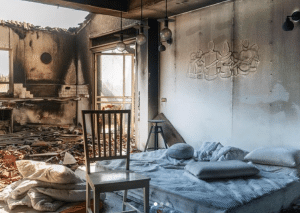
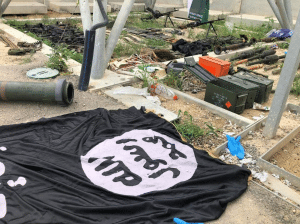
Remains of a family home in southern Israel (left). ISIS flag found in the Hamas terrorist’s belongings among scores of ammunition (IDF Spokesperson)
On October 7, Hamas launched an exceptionally brutal, sophisticated, and deadly attack on Israel, that caught the Israeli defense lines by surprise. In a span of several hours, Hamas’ Nukhba force, terrorists from the PIJ, Popular Front and Fatah’s Al Aqsa Martyrs’ Brigades, and scores of individual civilians from Gaza, invaded Israeli territories while incapacitating its defense lines and surveillance systems. Raiding military bases, towns, cities, and a large music festival attended by thousands of young adults near the border, Hamas terrorists brutally murdered at least 1,400 Israelis, wounded some 3,000, and took hostage at least 222 including babies, toddlers, youngsters, soldiers, and elderly. Documents found on terrorists’ bodies included instructions to decapitate civilians, torture, maim, rape, and take civilian hostages. Some notes included Al Qaeda propaganda and instructions on how to produce chemical weapons. Interrogated Hamas terrorists confessed to the scale of brutality, that rightfully, has gained a wide consensus as akin to the worst horrors of ISIS and the Nazi regime. Videos circulating onl ine showed agonizing civilians joyfully tortured and executed by terrorists as they ravaged any and all human beings, including scores of foreign civilians, committing some of the worst imaginable crimes against humanity.
Until October 7, Israel had led a policy of strategic containment with the Gaza Strip, in what was often referred to as a “division of attention” in its national priorities. Hamas in the Gaza Strip was perceived to be a fait donné, and the alternatives to its de facto Palestinian state in Gaza w ere deemed worse and would come at an extremely high cost. One may recall the leaked slidedeck presented by the IDF to the cabinet during the 2014 Protective Edge Operation, anticipating that taking over the Gaza Strip will take as much as five years and will lead to thousands of killed soldiers. Thus, each of the multiple “rounds of fighting”, limited operations between Israel and Hamas or Palestinian Islamic Jihad (PIJ) in the Gaza Strip between 2007-2023, had limited objectives to incapacitate certain military capabilities of these terrorist organizations and restore some degree of deterrence, while diverting attention to more strategic threats – chief among them, the Iranian nuclear program. Hamas, with all of its capabilities, was perceived as the “lesser evil”, that can be rationalized, contained, “bought off” with gestures such as increasing the quota of Israeli work permits for Gazans (most recently upped to 18,500), increased fishing range into the coast of Gaza, and Qatari funds designated to pay “silence fees” ($30 million UDF per month) to a much-needing Hamas government.

The 306 fallen IDF soldiers of the war
Following each such round, the Israeli government assured the public that a reinstated deterrence vis-à-vis Hamas or PIJ, buying time until the next round, while the latters were declaring victory and rebuilding their force immediately upon the commencement of the ceasefire. The guiding hand – the Iranian regime – was not assigned full accountability – and regional actors such as neighboring Egypt, that failed to act to prevent weapon smuggling into Gaza, and Jordan that incited its public against Israel’s right to self-defense in Gaza, were also contained out of the understanding that these peace agreements are strategic to assure Israel’s capacity to deal with larger, more pressing regional threats.
This time, however, there is a broad consensus in Israel that containment has reached its course, and it is high time to eliminate Hamas as a relevant entity in Gaza and elsewhere, while recalculating course of action vis-à-vis other fronts – Hezbollah in the military sense, Iran in the strategic sense, and pragmatic Arab countries in the diplomatic sense. The understanding is that weakness on the Gaza front will be translated into weakness on other fronts, soliciting other malign actors to intervene, as vice versa – decisiveness on the Gaza front will be translated into deterrence, possibly the expansion of Israeli-Arab peace on other fronts.
Israel now enjoys wide international credit, including strong, unequivocal support by the United States and multiple European allies, who seem to have gradually shifted their understanding of the root causes of the conflict and are supporting the continuation of the war to reach its objectives. Western countries also opposed UN resolutions proposed by Russia and China to establish a cease-fire, with multiple leaders such as President Biden and UK Prime Minister Sunak stating that a cease-fire will only allow Hamas to rebuild its force and enable them to launch such attacks again in the future. The United States sent two aircraft carriers to the region and an airlift of military aid, with Congress adopting 412-10 a resolution in support of Israel and condemnation of Hamas. President Biden, Secretaries Blinken and Austin, and a host of European leaders including from the UK, France, Germany, and the European Commission, came to Israel to express their support.
On October 16, the War Cabinet issued a document outlining the four objectives of the war:
- Toppling of the Hamas regime and the destruction of its military capabilities
- Removal of the Gaza Strip terror threat on Israel
- Ultimate effort to resolve the hostage issue
- Defense of the country’s borders and its citizens
The statement that Hamas must be completely destroyed was made by all senior ranks of the Israeli political and military echelon: Prime Minister Netanyahu, Defense Minister Gallant, Chief of Staff Lt. Col. Halevi and others. It was also made by President Biden and in the resolution passed by 500 MEPs in the European Parliament.
Israeli senior leadership has declared its willingness to enter into a long, demanding campaign that will take its toll, but whose objective is altering Israel’s strategic stance vis-à-vis its immediate borders and regional countries in the medium to long term.

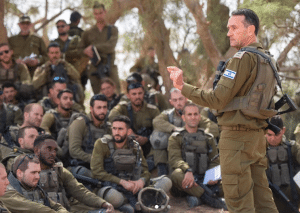
Left: The Israeli leadership in a meeting – Prime Minister Bejamin Netanyahu, Defense Minister Yoav Gallant, Chief of Staff of the Military Lt. Col. Herzi Halevi (Kobi Gideon, GPO)
Right: Lt. Col. Herzi Halavi speaking to soldiers in the front lines (IDF Spokesperson)
Will the war expand to the north?
So far, the northern front has seen escalation on a limited scale, with Iranian-backed terrorist organizations Hezbollah and Hamas taunting Israel by initiating incidents on the border, even killing six soldiers and one civilian. However, both Israel and Iran are carefully considering their next steps on whether or not to turn the northern escalation into a full-scale front in this war.
For Israel, this is an opportune moment to take the Iranian wildcard off the table, under the umbrella of strong international support, and remove the Hezbollah threat. There is a strong understanding in Israel right now that Israel, and in particular residents of the north, cannot live under the threat of Hezbollah, especially in light of the failure of the containment strategy in the south. The idea that Israel can allow Hezbollah’s Radwan elite unit to keep menacing northern border towns much like Hamas’ Nukhba unit ravaged the southern border towns, no longer holds water. Additionally, the invaluable international support for Israeli action, can be leveraged for a joint Israeli-American coalition to save Lebanon from Hezbollah. One must bear in mind, that in light of the belligerent declarations by the heads of Israeli political and defense establishment, and the fact Hezbollah is now the prominent political force in Lebanon, that the next war will not look like any previous war, and Lebanon itself, including its strategic assets, will be legitimate targets in the war.
For Iran, the dilemma on whether or not to force Hezbollah into intervention is critical. If Iran loses Hezbollah, it loses a significant shield that to a large degree deters Israel from attacking Iran itself and its nuclear facilities. Israel knows that in case of an attack on Iran, Hezbollah will undoubtedly join the war and inflict a heavy toll on the Israeli home front. A scenario of thousands of rockets and precision missiles per day rained down on Israeli cities and strategic infrastructure is a heavy price that Israel is well aware of. On the other hand, Iran also knows that the Israeli understanding that Hezbollah cannot be allowed to remain belligerent will behoove Iran to instigate a surprise attack itself, before Israel gets ahead of it, to start a war under favorable conditions.
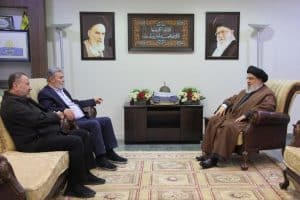
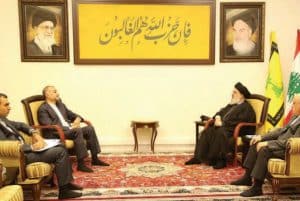
Hezbollah Secretary General meets Iranian Foreign Minister Abdullahian (right) and Hamas number two Saleh Al-Aruri and PIJ Secretary General Ziad Nahale (left) in his Beirut bunker
For now, Israel is interested in focusing its energies on the southern front, while preventing a wide-scale escalation in Judea and Samaria and among the Israeli-Arab cities and villages. “Isolation” between the fronts is a top Israeli interest, preventing scenarios of coalescence between the fronts, much like the chain of events that led to the 2021 Guardian of the Walls Operation. On the other hand, Israel better initiate the next confrontation on its own terms, rather than being dragged into it. Developments in the coming days and weeks will determine the course of the war on the northern and Iranian fronts.
Israel’s efforts are focused on the following fronts:
- Offensive – Gaza and to a limited extent the northern border:
- The Air Force has carried out thousands of sorties targeting Hamas infrastructure and other terrorist footholds in Gaza. These helped crumbling Hamas’ senior tactical leadership, its intelligence and offensive capabilities, and its strategic assets. They also assist in setting the scene for a ground offensive, that will be launched in due course. Over 300,000 reserve troops have reportedly drafted and are undergoing training and preparation as the political echelon, in cahoots with the military and heads of the defense establishment, devise an operational plan under a host of considerations. Air strikes continue unabated, reaching as many as 320 targets in a single day, including terror tunnels, apartments used by Hamas senior officials, rocket launching squads, weapon silos, squads intending to penetrate Israel by sea, and others.
- Meanwhile, efforts are being made on the Lebanese border to contain the escalation initiated by Hezbollah and Hamas forces in southern Lebanon. Almost daily incidents are instigated by the terror groups as part of their testing of Israel’s response, under the threshold of a full-scale war. These include the launching of anti-tank missiles, firefights on the fence, and rockets and attack drones that are intercepted by Israeli air defense systems or cause damage. So far, it claimed the lives of six Israeli soldiers and one civilian and wounded several others. The IDF retaliated with airstrikes and artillery fire on Hezbollah and Hamas posts and targets, yet the Israeli political echelon is not intending at this point in time to launch a pre-emptive strike against Hezbollah.
- The IDF also attacks Iranian and Syrian infrastructure in Syria, including weapon silos and airport runways, in order to prevent any advanced weapon to end up in the hands of Hezbollah in Lebanon and restrain the Iranian force buildup in Syria.
- Defensive – home front:
- Over 7,500 rockets and mortars were fired into Israeli territory since the beginning of the war, causing casualties and making direct hits on apartment buildings, while most were intercepted or landed in open air fields or in deserted streets. The Israeli home front landscape is dominated by reserve soldiers, handicapping both family life and the workforce at the same time. Many who have not been mobilized, as volunteering to host and assist evacuated families while sending goods to soldiers as well and families affected by the war. Many students have switched to studying via zoom given the situation. The economy continues to struggle to maintain some degree of routine.
- Meanwhile, over 100,000 Israelis were evacuated from their homes in the Gaza and Lebanon border, into hotel rooms, community centers and volunteer host families.
- Rapid Response Squads: Towns and cities across Israel have rushed to the help of the Israeli Police, Border Police, Home Front Command and localities to quickly establish rapid response squads, comprised of local residents, to meet immediate threats such as the potential incursion of terrorists. This policy is customary along the border, albeit insufficient to meet a large-scale threat as unfortunately demonstrated on October 7, yet still save lives. So far, over 500 such squads were established, armed and trained by the police and assisted by the military and volunteering civilians.
- Hostages: Both Prime Minister Netanyahu and IDF Spokesperson underscored that a top priority of this war is bringing back home all hostages. Estimates in Israel are that about half of the currently known 222 hostages are no longer alive. Pressure is being applied through relevant channels that can leverage their influence on Hamas and other groups, including the United States, Qatar, and Egypt. In an attempt to present itself as humane, Hamas has released four hostages thus far on a two-by-two basis, but senior Israeli officials say they will “not allow Hamas to fudge this war by dragging hostage release by months” while making demands to Israel such as the provision of fuel or ceasing all air strikes on Gaza.

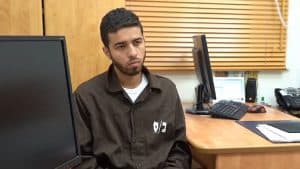
Documents found on the terrorists, with the title “Top Secret”, reveal instructions to rape, kidnap, and ravage schools and homes (left). Arrested Hamas terrorist reveals during an investigation the scale of atrocities and the instructions given to them (right)
- Gaza:
- The Israeli Air Force has launched one of the most extensive air campaigns in its history, attacking over 10,100 targets in more than 5,300 air strikes, managing to neutralize multiple terrorists. The target bank, backed by precision intelligence and guided missiles, includes Hamas military and governance infrastructure, militants firing rockets, rocket launch sites, weapon silos, training camp sites, and others. Some of those included the Hamas intelligence compound alongside a Hamas command and control center in the Islamic University, a network of reconnaissance cameras planted on solar thermal collectors on rooftops and designated to spot aircrafts, a command center owned by Hamas’ northern brigade, and other military targets.
- Among the senior Hamas officials targeted by the IDF were Belal Alqadra, commander of the Nukhba Southern Khan Yunis Assault Company and one of the perpetrators of the October 7 attack in Nahal Oz; Muhammad Abu Shamla, a senior Hamas Naval Operative in the Rafah Brigade; Muetaz Eid, the Commander of Hamas’ Southern District’s National Security; and Merad Abu Merad, Head of the Hamas’ Aerial Array in Gaza City.
- The IDF is making the utmost effort to avoid civilian casualties, dubbed “collateral damage.” The IDF has issued warning strikes, sent SMS messages, and dropped airborne leaflets i to provide a preemptive alert to the civilian population to evacuate. The IDF has ordered all residents of the northern part of the Gaza Strip to evacuate southward, and as of October 26, more than 750 thousand Gazans have successfully evacuated, as confirmed by the IDF.
- Reports on the Gaza death toll usually abide by numbers issued by Hamas, under the title “Gaza Ministry of Health”, which raises concerns over the international forum’s unwillingness to treat Hamas’ propaganda with a grain of salt. Figures such as 5,000 fatalities of which 40% are children, are being quoted at face value and taken as facts, both in UN reports and various media reports. This sensational outcry raises serious doubts over the UN and other forum’s ability to serve as honest brokers in the conflict, taking an Israeli-sceptic position while Hamas “cooks the books” and benefits from a propaganda bonanza that comes from a refusal to hold Hamas to any degree of accountability, while Israel is pressured to end its military campaign to topple Hamas and by extension, its ability to rebuild itself. Not only do Israeli intelligence doubt these numbers, but President Biden himself seems to concur: “I have no confidence in the number that the Palestinians are using. I have no notion that the Palestinians are telling the truth about how many people are killed. I’m sure innocents have been killed, and it’s the price of waging a war. (The) Israelis should be incredibly careful to be sure that they’re focusing on going after the folks that (are) propagating this war against Israel. And it’s against their interest when that doesn’t happen.” The WSJ also said the “figures could not be independently verified.”
- IDF spokesperson Daniel Hagari said that “Hamas is cynically abusing the civilian population while shooting from within civil sites such as kindergartens, schools, and mosques, while intentionally aiming at Israeli civilians.” IDF Spokesperson to International Media, Lt. Col. (res) Jonathan Conricus, said the IDF was encouraged to see “Gaza residents heeding that warning… we do our best efforts to avoid civilian casualties.”
Already in the first day on the offensive after Prime Minister Netanyahu issued a warning and implored the residents of Gaza to leave the area (“I’m hereby telling the residents of Gaza, get out now, because we will operate everywhere [in the Gaza Strip] and with our full might”.
Hiding behind civilians, placing its military infrastructure in densely-populated civilian areas and using civilians as human shields has been a long-standing tactic by Hamas to both attempt to avoid Israeli airstrikes while garnering international support and pressure on Israel to cease its strikes. Significant evidence over the years demonstrated Hamas’ abuse of UNRWA facilities, schools, hospitals, and other civilian sites for terrorist purposes. Meanwhile, the Gazan population is suffering intimidation, as confirmed by the IDF and multiple credible sources, by Hamas not to evacuate their homes. There is footage that even showed a car convoy of Gazan civilians being bombarded by Hamas in order to prevent them from evacuating. Other reports indicated Hamas constructs roadblocks to prevent their evacuation. “We are telling the people of northern Gaza, stay in your homes,” said Iad Al-Buzum, spokesperson for the Hamas Interior Ministry. “The occupier wants to uproot us from our country. We shall die before we leave.” The Gaza governmental media ministry ordered residents to “ignore” the evacuation warnings.
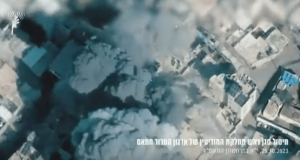
IDF documentation of the air strike that eliminated Hamas’ Head of Intelligence
- The Iranian guiding hand:
- The Iranian regime is known to have been a major actor in proliferating the regional terrorism infrastructure. In recent years, with the foundation of the so-called “Jerusalem Axis,” under the auspices of the IRGC – Iranian Revolutionary Guard Corps, Iran is attempting to coalesce all of their proxies into a singular iron fist while coordinating all factions. It is the strategy of the Iranian regime to “export the Islamist revolution,” and to that end it has been funding, training, and equipping terrorism all across the region, with Hezbollah receiving $700 million per year and Hamas $120 million. The United States has designated the IRGC and its Qods Force, who orchestrate this array of militias, as a terrorist organization and Iran itself as a state sponsor of terrorism.
- As the war unfolds, Iran continues to be extremely supportive of Hamas. As the IDF Spokesperson Daniel Hagari said, “Iran is continuing to assist Hamas as we speak.” In fact, a few short weeks before the attack, Hamas forces were on the ground in Iran for training camps. Many of the weapons captured by the IDF and used by the terrorists were originated from Iran itself, smuggled through the Rafah tunnels.
- Iranian leadership have also been vocal against Israel and in favor of Hamas. The Iranian leader has tweeted out on X a few short hours after the attack, “the Zionist regime is dying,” sharing a video of the fleeing Israelis at the attacked outdoor party. Iranian Leader then said on October 10, “We kiss the hands of those who planned the attack on the Zionist enemy. This devastating ‘earthquake’ has demolished infrastructure that cannot easily be fixed. The blame for this must be put on the Zionist regime itself.” President Raisi and other Iranian officials expressed support for Hamas’ attack as well.
- In a four-country tour around the Middle East, Iranian Foreign Minister Hossein Amir-Abdollahian met with Hezbollah Secretary General Hassan Nassrallah, Hamas’ number two Saleh Al-Aruri and PIJ Secretary General Ziad Nahale, assuring Iran’s support for them. Then, he met Hamas senior official Ismail Haniyyeh in Qatar, reiterating Iran’s backing for the organization. He also warned Israel against taking the next step and launching a ground offensive against Gaza, saying “an Iranian pre-emptive strike against Israel could be coming in the next hours.” (October 17)
- And indeed, such action was carried out. On October 19, Iranian Houthi proxy in Yemen, Ansarallah, launched five cruise missiles and 30 attack drones toward Israel, and reportedly intercepted by both Saudi (for the first time in history) and American forces. Saudi Arabia intercepted one of the missiles, while the USS Carney, a US Navy destroyer, intercepted the rest. “There is no question, the destination was Israel,” said one official. In parallel, Iranian-backed militias in Iraq have been launching attacks against US personnel and military bases in Iraq and in Syria, with 13 attacks over the span of one week. The expanding use of attack drones is one of the hallmarks of this evolving war and will continue to accompany Israel and its allies as a security challenge that will be addressed, much like missile and rocket interception is addressed by Iron Dome, Arrow, Patriot and other systems.
- Judea and Samaria (“West Bank”):
- Since the beginning of the war, the IDF has arrested over 800 ticking time bombs around the Judea and Samaria region, preventing attacks on Israelis. This long-standing IDF policy of freedom of operation around the territories helped prevent attacks targeting Israeli cities.
- Throughout the years, and increasingly since the 1994 Oslo Accords with the Palestinian Authority and the 2005 disengagement from Gaza, Israel has made significant sacrifices for peace, including compromising its own security. When essential security needs arose, Israel has preferred relying on its assumed partner, the Palestinian Authority, to arrest ticking time bombs scheming deadly attacks against Israeli citizens. The PA has proven almost useless in tackling these threats, whether unwilling or unable, and Israel is forced to defend its citizens by carrying out these counterterrorism raids with great risk to its soldiers.
- Since the 2002 Operation Defensive Shield, and recently in Operation Break the Wave and the 2023 Operation House and Garden in Jenin, these precision counterterrorism raids have proven invaluable in keeping Israeli citizens safe. Since the beginning of the year 2023 and until the breakout of the war, Israel has arrested over 1,500 terrorists and prevented more than 470 murderous attacks throughout the Judea and Samaria region, including shooting attacks, suicide bombings, and kidnappings.
- However, these just, necessary and proportionate measures were the subject of heavy criticism on the part of the international community, including harsh condemnations by the UN General Assembly, issuing in some cases 22 condemnations of Israel in a single year, mistruths about “excessive use of force” and “possible extrajudicial killings” voiced by the EU special envoy to the Palestinian arena, and others.
- No such arrests were possible in Gaza since 2005, allowing a deadly terror hub to flourish. The result, unfolded in full display in the October 7 massacre, has proven beyond doubt that there is no alternative to IDF activity on the ground to prevent terrorism from metastasizing.
- The domestic front: The concern of a multi-front conflict does not ignore the domestic front, namely the risk that much like the 2021 Operation Guardian of the Walls, there will evolve a large-scale violent uprising among the Israeli Arab population. This could happen in ‘mixed cities’ where Israeli Jews and Arabs live together such as Lod, Ramle, Acre, Jaffa, and Jerusalem; as well in pretty much exclusive Arab cities, such as Nazareth, Umm Al-Fahm and Sakhnin; the countryside; and among the Bedouin sector. So far, except for several severe cases of pro-Hamas incitement on social media that entailed immediate response by the law enforcement authorities, no irregular cases were noted. The entire Israeli defense establishment is on the highest level of preparedness now, and elements within Arab society are aware of that. Alongside it, the Commissioner of the Police, Maj. Gen. Yaakov Shabtai, after having warned the Arab sector not to intervene, said in a Knesset committee that “the Arab society is behaving in an exemplary way.”
Alongside this effort, unprecedently quick efforts to establish Rapid Response Squads in Israeli towns, localities, and cities, led to more than 500 new such squads to be established and to expand existing ones, to protect communities from the potential of such riots taking place.
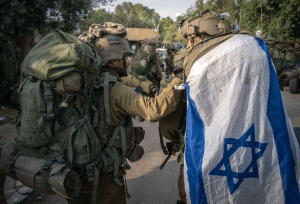
Paratroopers Brigade soldiers regain command of Kibbutz Be’eri after Hamas terrorists slaughtered hundreds of civilians (IDF Spokesperson)
- The information war – the fight over hearts and minds:
- The outbreak of the war has also released pro-Hamas, anti-Semitic “devils” out of the bottle, with mass pro-Palestinian rallies across cities in Europe and the United States, Arab capitals and around the world. Pro-Israeli rallies that support Israel’s cause and demand to release the hostages also dominated the streets. However, disturbing phenomena such as denial of the scale of the October 7 massacre did not only come from marginal sources, but prominent Arab figures and voices inside the United Nations. These voices not only laser-focused on Israel’s retaliation in the Gaza Strip, in a traditional fashion, but also denied its legitimacy to respond, exaggerated the toll of killed Gazan civilians, and automatically sided with the Hamas version of the events.
- The myth on the alleged Al Ahli Hospital attack in Gaza is one such example – there was instant broad consensus that Israel bombarded a hospital and caused the death of 500 Palestinians, while in fact a misfired PIJ rocket landed in the hospital’s parking lot, causing damage to a handful of cars. By the time the truth was revealed, damage was done, with masses rallying against Israel and prominent Arab countries such as Jordan, Egypt, and Saudi Arabia, strongly condemning Israel for crimes it had not committed.
- A chilling surge in antisemitism has swept across the globe in the aftermath of the attack, casting its shadow primarily over countries with sizable Muslim populations and vibrant Jewish communities. Across the United States, the Anti-Defamation League (ADL) has sounded the alarm, reporting a staggering 400% spike in antisemitic rhetoric. Between October 7 and October 23, 312 antisemitic incidents were recorded. ADL CEO Jonathan Greenblatt notes that when conflict ignites in Israel, antisemitic incidents quickly follow both in the U.S. and globally. Urging authorities to bolster security and support for Jewish communities, the ADL raises concerns over the hostile environments faced by Jews on college campuses amidst multiple protests in support of Hamas.
- Jewish communities in North America are responding with heightened security measures as emotions flare up over the tragic events in Israel and the looming invasion of Gaza. Pro and anti-Israel rallies have become daily occurrences across U.S. cities. Eric Fingerhut, CEO of the Jewish Federations of North America, reveals that despite comprehensive security programs, last Saturday’s Hamas attack has elevated the threat to an “entirely different level.”
- London, too, witnessed a distressing surge in antisemitic incidents since the commencement of the Israel-Gaza war, prompting Scotland Yard’s attention. Prime Minister Rishi Sunak vows to meet this “disgusting” rise with “the full force of the law.” In Australia, pro-Hamas protesters outside the Sydney Opera House were shouting “Gas the Jews.” Police are actively investigating this disturbing incident.
- Online platforms have become breeding grounds for hate speech, with a significant uptick in antisemitic posts observed in the four days following the Hamas attack. Other influencers used their platform to promote denial of the scale of the October 7 attack while exaggerating the scale of casualties in Gaza, with one influencer claiming one IDF attack “claimed the lives of 1,000 Palestinians”, with no foothold in reality. Pro-Palestinian figures, such as rapper Lowkey and activist Nerdeen Kiswani, added fuel to the fire with inflammatory statements justifying or downplaying the Hamas attack. The rhetoric extends to Twitch streamer HasanAbi, who appears to rationalize acts of extreme violence as a response to mistreatment in Gaza.
- A challenge for the international community will not only be leading a campaign against radical Islam, but also demonstrating conviction in confronting these phenomena.
- A risk for a World War: How this war is much more than an Israel-Gaza conflict
- With American, Russian, and Chinese interests involved in the region, Arab countries considering their next steps, and Iran fueling the Middle East with conflict generators, there is an understanding that this conflict is not limited to the narrow prism of the Israeli-Palestinian arena. The next few days and weeks will be crucial to the future of the Middle East and the arrangement of its axes of power. Pragmatic Arab countries such as Saudi Arabia could be weighing normalization with Israel, and Iran could retaliate in a severe fashion.
- This is also a test for the United Nations to reconsider its tradition of Israel-bashing. Even after Israel had withdrawn its forces and settlers from Gaza in 2005, the UN defined Israeli policy in Gaza as “occupation”. A few days after the attack, the UN Human Rights Council defined the “root cause” of the conflict as “the ongoing occupation” and called for a “Two State Solution.” Having pulled out of Gaza, and witnessing the devastating result, a clear conclusion for Israel cannot be withdrawing from Judea and Samaria as well, but instead, strengthening its foothold there while striving for a sensible political arrangement. World leaders will also do well to set aside past dogmas in favor of creative pathways, out of the understanding that the root cause is not Israel’s control of any territories, but fundamental anti-Semitism and commitment to the Palestinian armed struggle. Hamas invaded Israel even after it pulled all its forces out.
- The outrageous statement by the UN Secretary General Antonio Gutteres, that the Hamas attack “did not happen in a vacuum” which came after decades of “occupation, expansion of settlements and house demolition”, proves that international forums have yet to realize the nature of the threat Israel and the entire free world are facing.
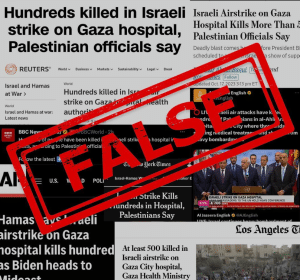
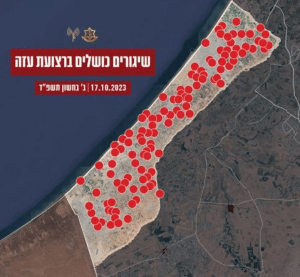
False news propagated by Hamas and taken face value by a host of actors claimed Israel bombarded the Al Ahli Hospital in Gaza, while in fact it was a misfired PIJ rocket